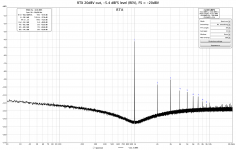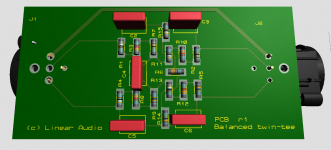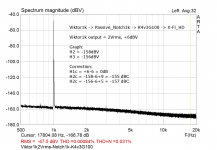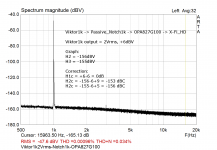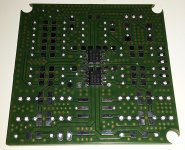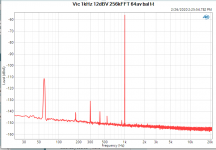Is the 2nd then about -120 if I understand your calculations?
Why do you convert to dBFS, why not to dBV as the signal is given?
Jan
Why do you convert to dBFS, why not to dBV as the signal is given?
Jan
The 2nd is -134.9dBFS or -154.9dBV.
The notch attenuation is 9.4 dB so the 2nd is actually 'only' -145.5dBV.
The fundamental is 14.6dBV and the difference thus 160.1dBV.
The REW software is not as flexible as your AP and as long as I cannot tell the software that the RTX is amplifying the signal by 20dB, I prefer to use dBFS and clearly state what the full scale is.
The notch attenuation is 9.4 dB so the 2nd is actually 'only' -145.5dBV.
The fundamental is 14.6dBV and the difference thus 160.1dBV.
The REW software is not as flexible as your AP and as long as I cannot tell the software that the RTX is amplifying the signal by 20dB, I prefer to use dBFS and clearly state what the full scale is.
Last edited:
> My balanced twin-tee PCB came finally in,
Which one are you referring to ?
Link ?
Thanks.
> delayed by that f*cking Corona virus ...
Some people risking their lifes to get your PCB done !!
P.
Which one are you referring to ?
Link ?
Thanks.
> delayed by that f*cking Corona virus ...
Some people risking their lifes to get your PCB done !!
P.
> delayed by that f*cking Corona virus ...
Some people risking their lives to get your PCB done !!
P.
I realize that, and I don't blame the people for the delay etc. I am sure it must be a hard time for them, and to be honest they did their best to get the boards out asap.
BTW discovered some nice Neutrik XLRs. They consist of an inner part that you put on the PCB and an outer part that you mount on a panel. That way you can take out the board & connectors without having to dismantle the box! A plug-in plug, so to say.
All fits in a 1590BS Hammond diecast box.
Jan
Attachments
Last edited:
Looking for suggestions for an already built tone generator that will cover 0-100hz (or maybe more). Cheap of course.
I need to break in some reconed 15" woofers and need to drive them for a day or two at 20hz to loosen them up, before I assess the T/S parameters.
Suggestions?
Thanks
Greg
I need to break in some reconed 15" woofers and need to drive them for a day or two at 20hz to loosen them up, before I assess the T/S parameters.
Suggestions?
Thanks
Greg
I currently have a setup like that using a laptop, but6 I am looking for something a little more portable.
Thanks for the suggestion.
Thanks for the suggestion.
Any DDS generator will do for breaking-in speakers, e.g. New DDS Function Signal Generator Module Sine Square Sawtooth Triangle Wave 700755554468 | eBay
But please create a new thread, this one is about ultra-low-distortion generators, used for measurements. The link above kind of does not belong here 🙂
But please create a new thread, this one is about ultra-low-distortion generators, used for measurements. The link above kind of does not belong here 🙂
I currently have a setup like that using a laptop, but6 I am looking for something a little more portable.
Thanks for the suggestion.
Cell phone app?
Pretty portable ;-)
Jan
Just now I have tested my new 40dB preamp (discrete, jfet input).
The chain : Viktor1k_2Vrms -> passive_notch1k -> preamp40dB -> X-Fi_HD
The result is slightly better than the OPA827 based post-notch solution.
In any case, H2/H3 is under -150dB.
View attachment 820381
View attachment 820382
Very nice! Is that 40dB preamp in the open?
Jan
Here you go. Power amp measurement system
Originally designed as a front-end for my HEC buffer. I had some spare boards, so I tried it as a preamp.
Originally designed as a front-end for my HEC buffer. I had some spare boards, so I tried it as a preamp.
My balanced twin-tee PCB came finally in, delayed by that f*cking Corona virus ...
I used EuroCircuits this time for my State Variable board. Ran out of 1206 decoupling caps though 🙁.
Attachments
Just now I have tested my new 40dB preamp (discrete, jfet input).
The chain : Viktor1k_2Vrms -> passive_notch1k -> preamp40dB -> X-Fi_HD
The result is slightly better than the OPA827 based post-notch solution.
In any case, H2/H3 is under -150dB.
View attachment 820381
View attachment 820382
Should it not be '+6-9'? The fundamental is +6dBV so that adds to the distortion distance between fundamental and distortion in dBV. The 2nd is attenuated by 9dB (I guess) so that subtracts. Not a big change though.
I also looked at your sim of this. I see that the OL gain at 20k is ~90dB. With a 40dB CL gain, and -150dB distortion at 20k, that means the OL distortion is about -100dB at 20k. That is unbelieveable!
Jan
Jan
Last edited:
The graph I posted before of the Viktor with bal twin-tee was not correctly referenced.
I redid it, with correction for notch attenuation of 2nd, and setting the Vicnic to 4V (+12dBV) to push the noise down a few more dBs.
This now is correctly scaled.
Jan
I redid it, with correction for notch attenuation of 2nd, and setting the Vicnic to 4V (+12dBV) to push the noise down a few more dBs.
This now is correctly scaled.
Jan
Attachments
- Home
- Design & Build
- Equipment & Tools
- Low-distortion Audio-range Oscillator
